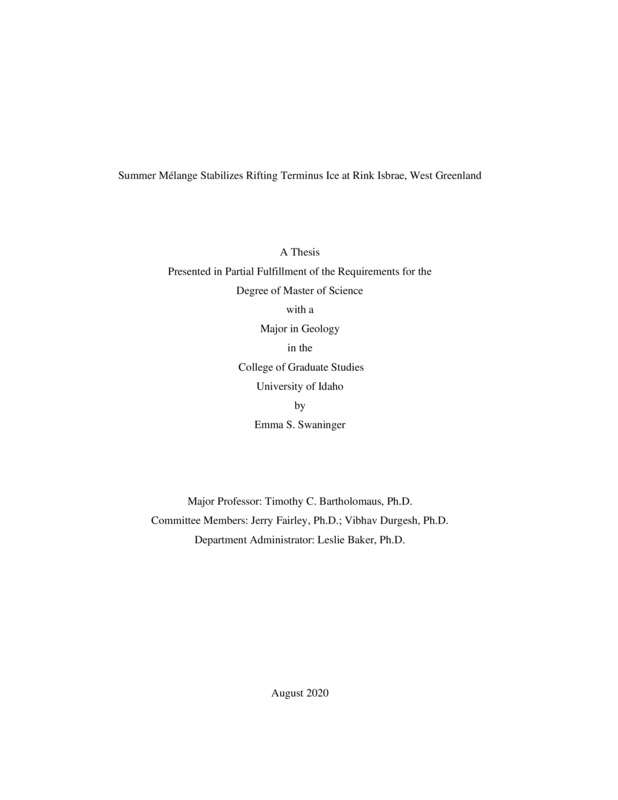Summer Mélange Stabilizes Rifting Terminus Ice at Rink Isbrae, West Greenland
Swaninger, Emma Sue. (2020-08). Summer Mélange Stabilizes Rifting Terminus Ice at Rink Isbrae, West Greenland. Theses and Dissertations Collection, University of Idaho Library Digital Collections. https://www.lib.uidaho.edu/digital/etd/items/swaninger_idaho_0089n_11935.html
- Title:
- Summer Mélange Stabilizes Rifting Terminus Ice at Rink Isbrae, West Greenland
- Author:
- Swaninger, Emma Sue
- ORCID:
- 0000-0002-1153-7941
- Date:
- 2020-08
- Keywords:
- calving glacier greenland ice mélange iceberg shear strength
- Program:
- Geology
- Subject Category:
- Geology
- Abstract:
-
Ice mélange is a densely packed, granular material consisting of icebergs bound together with sea ice in a rigid matrix at glacier termini. Ice mélange has been shown to affect glacier stability and terminus dynamics at some tidewater glaciers by influencing glacier advance and retreat, inhibiting calving, changing fjord circulation, and altering near surface ocean temperatures which can change iceberg melt rates. Prior studies have focused on extreme cases of mélange formation where mélange exists year-round or in winter. These studies indicate that mélange can provide significant back stress or a “buttressing” effect on the terminus through lateral resistance with fjord walls and dynamic jamming of mélange which creates large localized resistive stresses. For some Greenland glaciers, a short-lived mélange can develop following winter mélange disintegration and this mélange’s ability to impact terminus flow is undetermined. Here, I illustrate the capability of short-term, summer mélange at Rink Isbræ, West Greenland to compress and stabilize a rifting piece of terminus, that we term a loose "ice tooth," torn open following three large calving events ranging in surface area from 0.22 km2 to 0.64 km2. Using terrestrial radar interferometry, I analyze variations in glacier and mélange velocities within 0.5 km of the terminus of Rink Isbrae during calving events, evaluate mélange rigidity, and determine the forces acting on a calving iceberg to estimate the shear strength of terminus ice at Rink Isbrae. While the mélange did not affect flow of fully attached glacier ice, mélange indirectly influences glacier dynamics by 1) compressing developing mélange on the ice tooth, which slowed down the ice tooth after calving, and 2) temporarily stabilizing the ice tooth as the mélange developed through ice-to-rock contact along the fjord walls. The in-situ terminus shear strength I find, 50 kPa to 540 kPa, falls on the low end of shear strengths of ice proposed by prior field and theoretical experiments, which have been observed to fall between 200 kPa and 1000 kPa. The shear strength of ice is not well constrained due to lack of observational data, and this measurement may be more representative of a material property at actual tidewater glaciers than measurements developed from models in prior research. Additionally, slab capsize calving creates a domino effect where more calving is triggered through rifting of ice laterally connected to the calving iceberg. In Greenland, other tidewater glaciers that display slab capsize calving and have semi-confined to confined fjords have analogous mélange occurrences which suggests that summer mélange is important when considering short-term calving behavior and long-term glacier evolution.
- Description:
- masters, M.S., Geology -- University of Idaho - College of Graduate Studies, 2020-08
- Major Professor:
- Bartholomaus, Timothy C
- Committee:
- Fairley, Jerry P; Durgesh, Vibhav
- Defense Date:
- 2020-08
- Identifier:
- Swaninger_idaho_0089N_11935
- Type:
- Text
- Format Original:
- Format:
- application/pdf
- Rights:
- In Copyright - Educational Use Permitted. For more information, please contact University of Idaho Library Special Collections and Archives Department at libspec@uidaho.edu.
- Standardized Rights:
- http://rightsstatements.org/vocab/InC-EDU/1.0/

